Art & Exhibitions
‘I Believe Strongly in Vulnerability’: Curator Prem Krishnamurthy on What Cleveland’s FRONT Triennial Can Teach About the Healing Power of Art
The ambitious exhibition is open across dozens of venues in northeast Ohio.

The ambitious exhibition is open across dozens of venues in northeast Ohio.

Taylor Dafoe

The night the newest edition of the FRONT International opened in Cleveland, the show’s curator, Prem Krishnamurthy, could be found at karaoke bar called Tina’s, belting out a beery rendition of Britney Spears’s Toxic. Before him was a rag-tag crowd of local barflies, goth kids, rust-belt cowboys, baseball bros—as well as a cadre of the international art world there for the show. Everyone was singing along.
Tina’s wasn’t one of the official sites of the triennial exhibition (which is funny, because seemingly every other venue in Northeast Ohio is), but Krishnamurthy called the event the “crux of the show.”
“Karaoke,” he said, “can be such a leveling force. There, in that big room, there are all these different people you don’t know, but everybody’s cheering each other on. When somebody sings, everybody else claps for them and everybody else joins in. To me, that is beautiful.”
Positive are the vibes conjured by Krishnamurthy’s edition of FRONT, the second since the Cleveland-based event was founded in 2018. The show, titled “Oh, Gods of Dust and Rainbows,” spans dozens of venues across Cleveland, Akron, and Oberlin, and features work by more than 100 artists both local and international, alive and dead. All of it coalesces around the curatorial conceit of the show, which is about embracing “art as an agent of transformation, a mode of healing, and a therapeutic process.”
The title comes from “Two Somewhat Different Epigrams,” a 1957 poem by Langston Hughes, who spent his teen years in Cleveland and whose presence remains strong in the city:
I
Oh, God of dust and rainbows, help us see
That without dust the rainbow would not be.
II
I look with awe upon the human race
And God, Who sometimes spits right in its face.
Turning to art for regeneration and repair feels on brand for 2022, but Krishnamurthy and his team actually settled on that theme back in 2019. After the show’s busy opening weekend, Krishnamurthy spoke with Artnet News about the evolution of that and the other ideas at the heart of his ambitious triennial.
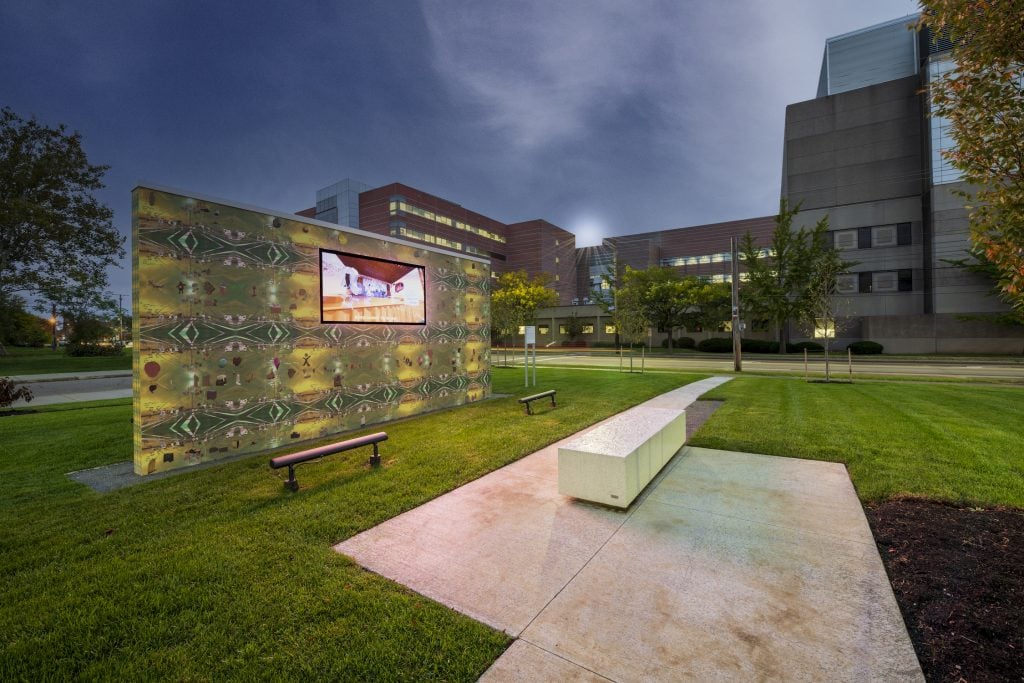
Jacolby Satterwhite, Dawn (2021). Photo: Cleveland Clinic. Courtesy of the artist and Mitchell-Innes & Nash, New York.
Langston Hughes looms large over the exhibition. It’s from him that the show take its name, and there are several exhibitions that feature or otherwise allude to his writing, his voice, his persona. What did you find in Hughes as you were putting the show together?
I think there are multiple things about Langston Hughes that appealed so strongly to us when we were first curating the show in 2019. Of course there’s his Cleveland connection, which is how we came to him initially. During that period, our curatorial assistant Lo Smith researched Hughes and actually presented back to the curatorial team the idea that Langston Hughes was almost a kind of contemporary artist in the way that he worked polymathically between different fields.
When he was in Cleveland, he had already been writing poetry for a long time. But as a teenager, he taught in the Karamu House art workshop and produced prints and was making visual art. He organized plays and performances and events that we might think of as happenings. That his career was so multivalent and was really fascinating. I think that in Langston’s work, and in his biography, there is a questing that happens from a very early age, but also a lot of trauma and suffering embedded in it.
We actually chose the title of the show while we were still formulating what it would be about, still figuring out the artists we wanted to include. So it all kind of emerged organically. And somehow then, once we had this title, “Oh, Gods of Dust and Rainbows,” it became a thing that we could really come back to and let resonate in many different ways.
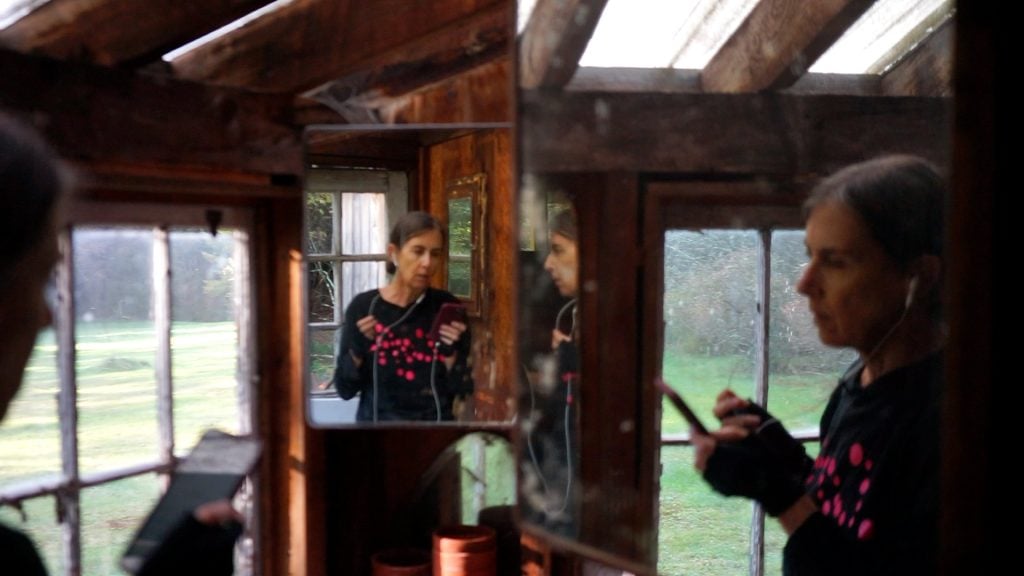
Moyra Davey, Still from Horse Opera (2019–22). Courtesy of the artist; Greengrassi, London; and Galerie Buchholz, Berlin, Cologne, and New York.
What did that title mean to you then and what’s your relationship to it now?
I can’t tell you how many times I’ve read that poem over the last two and a half years. Every time I did, it had some different resonance for me. When we started, it was very philosophical and was also very imagistic. There was something in the idea of dust and rainbows that immediately set people’s imaginations on fire.
From the very beginning, we wanted to reproduce the entire poem whenever we referenced it because the second part has quite a different tone than the first. This idea that God sometimes spits right in man’s face—there’s something very pointed and very brutal about that which appealed to us. But I have to say that, now, from the position of having worked on this for years, having worked on it through a pandemic, through global calls for social and racial justice, through seeing the environment collapse around us—and through a lot of personal challenges—the meaning has changed. It has begun to seem to me almost like a Buddhist sentiment, this inseparability of joy and suffering.
Making this exhibition—there’s been a lot of dust. It’s been really challenging to produce a show under these conditions and in this time, but then the fact that something so beautiful comes out of it on the other end, that’s really remarkable.
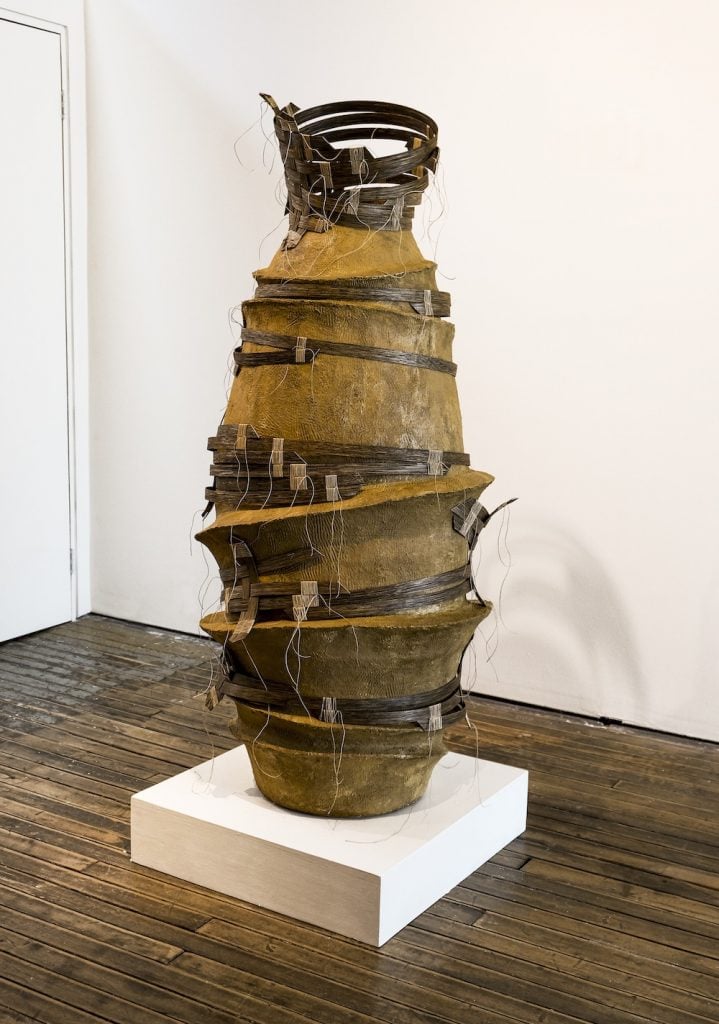
Charmaine Spencer, Water (2021), installation view, The Sculpture Center, Cleveland. Courtesy of the artist.
The show posits art as “an agent of transformation, a mode of healing, and a therapeutic process,” which of course feels very apt in 2022. But, as you mentioned, that concept was first settled on back in 2019, prior to the pandemic and other recent upheavals. What were you thinking of back then?
In 2019, when we were intensively researching the show, we were thinking, first of all, about the context of northeast Ohio, thinking about the historical traumas that the region has faced. A hundred years ago, Cleveland was the fifth or sixth largest city in the U.S., I believe. People here often say, back then, there were more millionaires in Cleveland than there were in New York. The city had this incredible prosperity that was generated through companies like Standard Oil, which was founded there, and the steel industry. But that same wealth that was produced in the region led to the destruction of the environment. It led to the destruction of people’s lives in terms of exploitation and the conditions of work in that moment. It set the stage for all of these issues that are problems in Cleveland today and have been over the last 50 years.
But something that Murtaza Vali, who is part of our artistic team, brought to the table was this realization that the industrial labor and industrial wealth had given way to a focus on health services in the region. The Cleveland Clinic is the largest employer in the city. Art Therapy Studio, which was one of the earliest independent organizations for art therapy, was founded there. Alcoholics Anonymous was started in Akron and the National Museum of Psychology is there too. So around 2019, we coalesced this idea and then launched the triennial with the title that it has and the focus on art and healing.
Then, two months later, the world shut down.
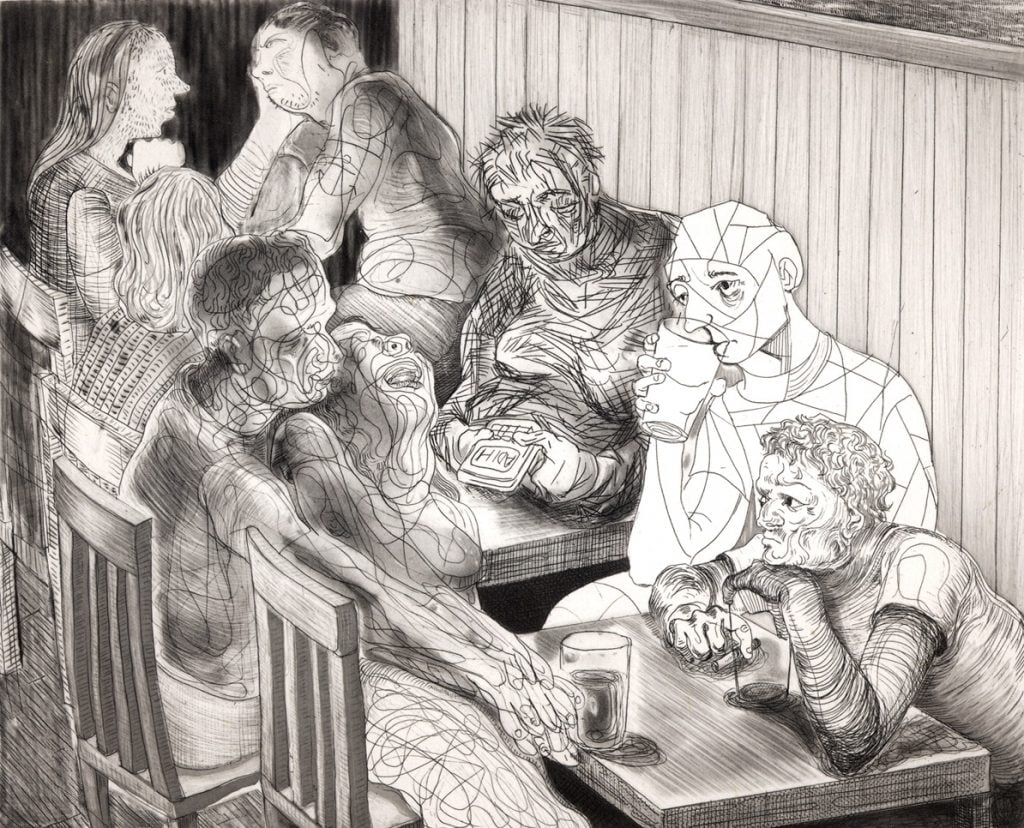
Nicole Eisenman, Drinks at Julius (2012). Courtesy of the artist and Hauser and Wirth.
How did the conversation about the curatorial conceit of the show evolve from that point on?
When we first started talking about healing and therapy in 2019, I think both of us felt a certain reticence about it. It was something that both of us were deeply invested in our own lives and in our work, but I think we were a little embarrassed. We thought in 2019 that it could be seen as too esoteric or too hippie-dippie or somehow not serious enough for the art world. But we went with it. I believe really strongly in vulnerability and I think we went with what was really close to us and we said, ‘This is something we really care about and we’re gonna do it. Hopefully people will go with it.’
Then the pandemic hit and we almost got to the other end of the spectrum where there were suddenly so many projects focused on healing. It became clear to me that we had to articulate healing as something more than an abstract concept. How can art making be healing both for the maker and for the receiver?
I grew up in a first-generation immigrant family where the idea of doing art was absurd. It was seen as frivolous and I always thought of it as being selfish; that if you did art, you were doing this thing that was too much for yourself, had too much ego in it. For me, it took this moment—the pandemic and the lockdown—to really like dig into this question of how art can heal on an individual level, as a daily practice; and heal on the level of the collective, through sharing joy and through pleasure and music and dance and craft and color; and, at the same time, also create structural change. How can it actually do that in these different ways? And so it’s been about testing out this proposition to see, can we draft an idea of how art might really work in all of these ways for the individual and for the planet as a whole?
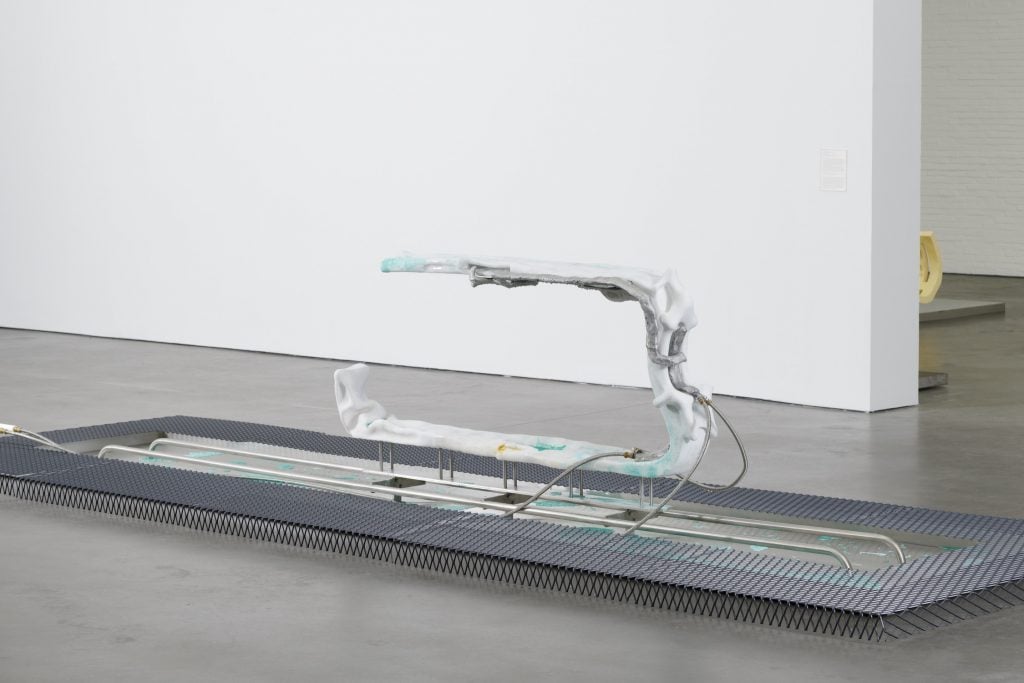
Isabelle Andriessen, Necrotic Core (2021). Photo: Aurélien Mole. Courtesy of the artist.
Across the exhibition are many different, and often personal, responses to those questions you just posed about art’s capacity for healing. Can you walk me through how this theme of healing through art is expressed in some of the projects included in FRONT?
On the scale of the individual and thinking about daily practice, there’s a big spectrum of examples. I’m thinking about somebody like Julie Mehretu and the mindfulness that she brings to making art, how she paints every day. We’ve really tried to emphasize that healing-through-work approach with the show she curated at the Cleveland Museum of Art. It’s something that resonates with Theaster Gates’s film A clay Sermon, which is about his own origins as an artist. Theaster is an artist who works on the structural level, but my hunch is that he couldn’t do that unless he could also find a way to satisfy himself to an individual level. That comes through his work with clay and ceramics. That’s what this film is really about in my mind. But it also uses music and joy to bring people together.
There’s also Paul O’Keefe, based in Cleveland, who has used the medium of sculpture to deal with a horrific, unthinkable loss—his son’s suicide at 22. He’s using the language of sculpture as a way to process and integrate that. And there’s Dexter Davis, who is responding to a violent trauma—a shooting that he experienced—but doing that through a daily process of collage that allows him to continue.
Those are some examples on the level of the individual, but on the level of the collective or the group, there are so many projects that come to mind. Maybe one of the most obvious is Asad Raza’s project Delegation. Raza brought a group of musicians on a boat from his hometown of Buffalo to Cleveland. They spent three days on the water—an extremely challenging trip—composing a piece. Then they played that piece once in an old stone church. On the level of performance, it broke so many things down and was just about being together.
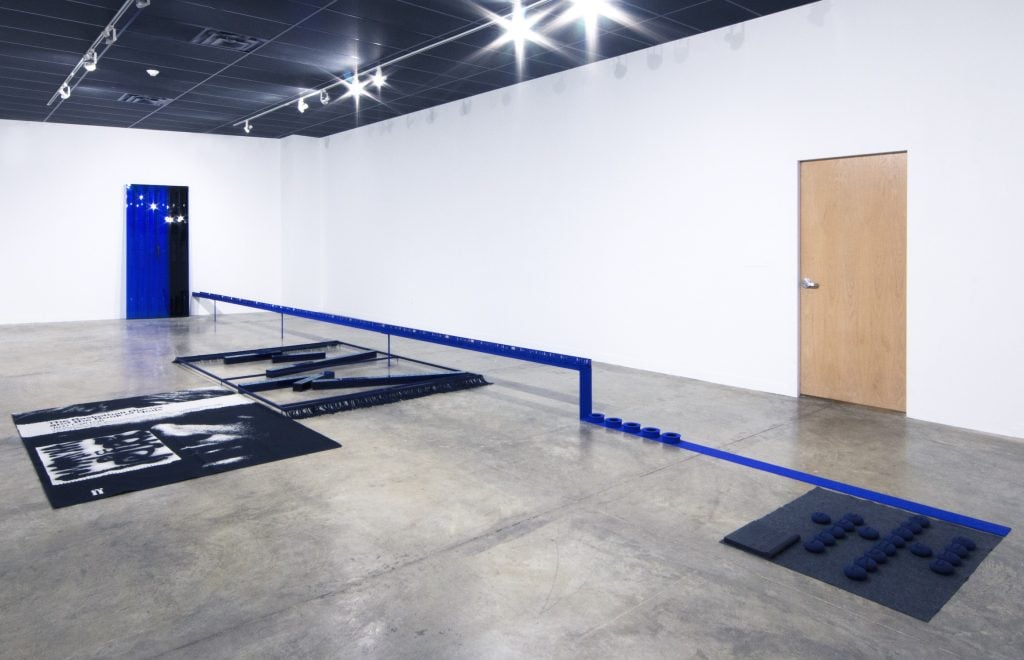
Paul O’Keeffe, Screaming Voicelessly to a Distant Silence, installation view, the Sculpture Center, Cleveland, 2017. Photo: Jacob Koestler. Courtesy of the artist.
And on the level of the structural and speaking with power, there are examples like Jacolby Satterwhite, who has engaged in a long-term collaboration with the Cleveland Clinic, a major organization that has a historically fraught relationship with its black neighbors and community. What emerged out of it is something that’s challenging to everybody involved, but I think it also changed them.
There’s also Cooking Sections’s project on lake Erie and their work that will unfold over the next three years with local farmers that is about changing the farming practices in the region to make them regenerative. It’s about using art, which has certain funding structures, has a certain visibility, to incur change.
Finally, I wanted to ask you about karaoke, which struck me as a very fitting end to FRONT’s kick-off weekend, even if it wasn’t officially part of the show. There was a lot of healing happening in that room.
I think of karaoke is probably the best metaphor for all of this. Where is the art in it? The art is not only in what you’re seeing, but it’s in what you bring to it, how you sing it, and whether you’re all in or not.
“Oh, Gods of Dust and Rainbows” is on view at various venues across northeast Ohio now through October 2, 2022.